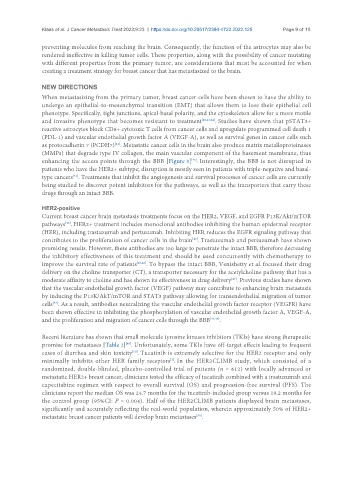Page 435 - Read Online
P. 435
Klaas et al. J Cancer Metastasis Treat 2023;9:23 https://dx.doi.org/10.20517/2394-4722.2022.125 Page 9 of 15
preventing molecules from reaching the brain. Consequently, the function of the astrocytes may also be
rendered ineffective in killing tumor cells. These properties, along with the possibility of cancer mutating
with different properties from the primary tumor, are considerations that must be accounted for when
creating a treatment strategy for breast cancer that has metastasized to the brain.
NEW DIRECTIONS
When metastasizing from the primary tumor, breast cancer cells have been shown to have the ability to
undergo an epithelial-to-mesenchymal transition (EMT) that allows them to lose their epithelial cell
phenotype. Specifically, tight junctions, apical-basal polarity, and the cytoskeleton allow for a more motile
and invasive phenotype that becomes resistant to treatment [40,43,44] . Studies have shown that pSTAT3+
reactive astrocytes block CD8+ cytotoxic T cells from cancer cells and upregulate programmed cell death 1
(PDL-1) and vascular endothelial growth factor A (VEGF-A), as well as survival genes in cancer cells such
[41]
as protocadherin 7 (PCDH7) . Metastatic cancer cells in the brain also produce matrix metalloproteinases
(MMPs) that degrade type IV collagen, the main vascular component of the basement membrane, thus
[45]
enhancing the access points through the BBB [Figure 3] . Interestingly, the BBB is not disrupted in
patients who have the HER2+ subtype; disruption is mostly seen in patients with triple-negative and basal-
type cancers . Treatments that inhibit the angiogenesis and survival processes of cancer cells are currently
[42]
being studied to discover potent inhibitors for the pathways, as well as the transporters that carry these
drugs through an intact BBB.
HER2-positive
Current breast cancer brain metastasis treatments focus on the HER2, VEGF, and EGFR P13K/Akt/mTOR
[43]
pathways . HER2+ treatment includes monoclonal antibodies inhibiting the human epidermal receptor
(HER), including trastuzumab and pertuzumab. Inhibiting HER reduces the EGFR signaling pathway that
[45]
contributes to the proliferation of cancer cells in the brain . Trastuzumab and pertuzumab have shown
promising results. However, these antibodies are too large to penetrate the intact BBB, therefore decreasing
the inhibitory effectiveness of this treatment and should be used concurrently with chemotherapy to
improve the survival rate of patients [45,46] . To bypass the intact BBB, Venishetty et al. focused their drug
delivery on the choline transporter (CT), a transporter necessary for the acetylcholine pathway that has a
[47]
moderate affinity to choline and has shown its effectiveness in drug delivery . Previous studies have shown
that the vascular endothelial growth factor (VEGF) pathway may contribute to enhancing brain metastasis
by inducing the P13K/AkT/mTOR and STAT3 pathway allowing for transendothelial migration of tumor
cells . As a result, antibodies neutralizing the vascular endothelial growth factor receptor (VEGFR) have
[43]
been shown effective in inhibiting the phosphorylation of vascular endothelial growth factor A, VEGF-A,
and the proliferation and migration of cancer cells through the BBB [44,48] .
Recent literature has shown that small molecule tyrosine kinases inhibitors (TKIs) have strong therapeutic
promise for metastases [Table 2] . Unfortunately, some TKIs have off-target effects leading to frequent
[49]
cases of diarrhea and skin toxicity . Tucatinib is extremely selective for the HER2 receptor and only
[50]
minimally inhibits other HER family receptors . In the HER2CLIMB study, which consisted of a
[3]
randomized, double-blinded, placebo-controlled trial of patients (n = 612) with locally advanced or
metastatic HER2+ breast cancer, clinicians tested the efficacy of tucatinib combined with a trastuzumab and
capecitabine regimen with respect to overall survival (OS) and progression-free survival (PFS). The
clinicians report the median OS was 24.7 months for the tucatinib-included group versus 19.2 months for
the control group (95%CI: P = 0.004). Half of the HER2CLIMB patients displayed brain metastases,
significantly and accurately reflecting the real-world population, wherein approximately 50% of HER2+
[50]
metastatic breast cancer patients will develop brain metastases .

